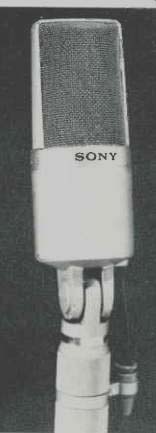
MANUFACTURER'S SPECIFICATIONS
Capsule: Back-electret condenser.
Directivity: Unidirectional.
Impedance: 250 ohms ±20 percent at kHz, balanced.
Frequency Response: 20 Hz to 20 kHz.
Output Level: Effective output level-53.8 . dBm. (0 dBm=1 mW/10 p Bar, 1000 Hz); open circuit voltage, 0.2 mV/ p Bar at 1000 Hz, output level deviation ±2 dB.
Recommended Load Impedance: More than 3 kilohms.
Maximum Input Level: Approximately 134 dB SPL.
Noise Level: Less than 28 dB SPL (0 dB SPL2x10-° p Bar).
Wind Noise: Less than 40 dB SPL at 2 m/S velocity.
Induction Noise from External Magnetic Field: Less than 5 dB SPL at 1 milli-gauss, 50 Hz.
Power Requirements: 7 to 9 V d.c., 1 mA max. from internal battery or 24 V54 V d.c. 3.5 mA max. from external power supply.
Battery Life: Approximately 400 hrs.
with Eveready 216 manganese, or approx. 600 hrs. with Eveready E146 mercury.
Cable: Attached, 7/32-in. diameter (5.2 mm), 2-conductor shielded cable with Cannon XLR-3-12C plug, 20 ft. (600 cm).
Mounting Thread: PF 1/2 Dimensions: 2 in. (5 cm) x 8 3/8 in. (20.7 cm).
Weight: 1.06 lbs. (500 gms).
Finish: Non-reflective satin nickel.
Accessories Supplied: Stand adaptor PF 1/2 to NS 5/8.
Price: $220.00.
The Sony ECM-56F will appeal to audiophiles who want condenser performance with the simplicity of a dynamic or ribbon mike. Unlike some contemporary condensers, it is not a "system" mike, and has no interchangeable capsules, windscreens, etc. Simplicity is further enhanced by the permanently attached cable compete with an XLR 3-pin plug on the end, so there's no soldering to do if your recorder or mixer has professional-type balanced inputs. We did not, however, escape reading the instructions because the battery is well concealed by a perfectly machined and fitted housing. The lower shell unscrews and drops downward, allowing access to battery and electronics.
We've always preferred a mike with radial sensitivity for distant miking of orchestra and chorus, and Sony has included some calibration marks on the swivel which facilitates duplication of tilt angles. (Radial means you talk into the side, as distinguished from axial sensitive mikes where you talk into the end.) The advertising literature indicates that Sony has designed the ECM-56F and other mikes in their "back-electret" line as a medium cost substitute for air-condenser microphones in audiophile or professional studio applications. The inclusion of additional electronics inside the mike, as required for remote "phantom powering," opens up a wide variety of applications such as recording or broadcast studios and permanent installations for sound reinforcement or recording. With remote powering, the internal battery is removed, and power is supplied through the standard two-conductor shielded microphone cable. "Phantom powering" is normally found in professional air-condenser mikes and has been discussed in our recent reviews. Sony ECM-56F may be operated into a balanced input with grounded center tap when you're using battery power, without short circuiting the power source.
Similarly, it may be used into un-balanced inputs by grounding one output line and replacing the three-pin connector with the desired two-circuit plug.
The "back electret" is a recent development by Sony. The rationale makes a lot of sense to this reviewer who has had considerable experience with the testing and selection of diaphragm materials. The design of an electret capsule has always necessitated a compromise between mechanical and electrical properties of the plastic film which functions both as a diaphragm and as a "permanently" charged dielectric, as in a capacitor. A film such as Teflon has good electrical properties for use as an electret, but it is mechanically very limp and is practically useless as a diaphragm. On the other hand, a polyester film such as Mylar is stiff and ideal as a diaphragm, but does poorly as an electret. (Mylar is a good dielectric and is used in capacitors but is not suitable for use as an electret.) Instead of going to a different film with compromise properties, Sony has attempted to achieve the "best of both worlds" by utilizing the two ideal types of films in a single capsule. The electret film, which is described only as "high polymer," is placed more or less in contact with the back plate. The diaphragm fill, which is stated to be "polyester," is mounted on top, and separated from the electret film by a small air space. Kubota ' states that this composite transducer called the back electret performs better than conventional electrets, and presumably equal to air condensers.
The capsule of the ECM-56F, about 5/s-inch diameter and 3/s-inch thick, perches on top of the lower housing and is surrounded by an open-mesh windscreen. The screen is an elaborate affair consisting of an outer coarse-weave wire mesh which provides mechanical strength, and two layers of fine weave mesh inside, which does the windscreening. As stated previously, the electronics and battery are in the lower housing.
In addition, there is an internal switch providing 8 dB reduction in sensitivity if desired and a battery test lamp visible from the outside on the bottom of the housing. The Off-M-V switch is in the middle front of the mike and provides power switching and low frequency attenuation.
The appearance, quality, and durability of the ECM-56F seem to be excellent. We encountered one difficulty in the area of biomechanics. The front and backs of the mike are identical in appearance save for the switch. We had to consult the manual to find that the switch is on the front side. It is our opinion that the switch location does not necessarily denote the front, because on some mikes the switch is on the back. We suggest that Sony add an engraving such as "Front" or "Back."
Laboratory Tests
The impedance with flat response (M) setting (Fig. 1) is satisfactorily close to the 250-ohm nominal value. It is higher than the 180-ohm maximum value recommended by the EIA Standard for 150-ohm mikes, but a 250-ohm mike generally may be used with "unloaded" inputs rated from 150 to 600 ohms.
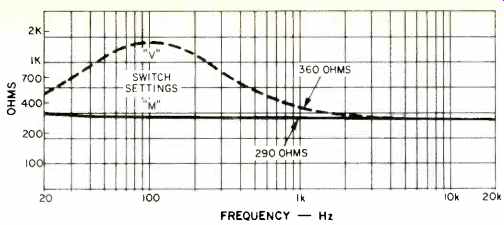
Fig. 1--Impedance with the internal attenuator switch setting at "0" or
-8 dB.
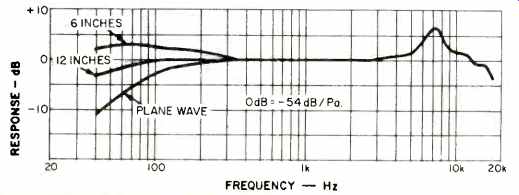
Fig. 2--Frequency response vs. distance.
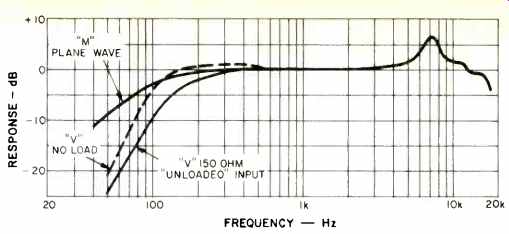
Fig. 3--Effects of load on the low-frequency response compensation.
On bass roll-off (V) setting, the impedance peaks at about 1500 ohms, so the degree of bass rolloff will vary with the 4 actual input impedance of the preamp. The 150-ohm input of our BA-31 Broadcast Microphone Preamp measures about 1500 ohms at 50 Hz, increasing with frequency, and Sony recommends 3000 ohms or greater load impedance.
Figure 2 shows the on-axis frequency response. There is considerable bass rolloff for plane-wave conditions, so equalization may be needed for distant miking. Sony's curve (in the instruction manual, no individual curve supplied) matches our 12-inch curve at low frequencies. It is likely that Sony's curve is not for plane waves but for a finite source distance of about 50 or 100 cm.
We were concerned about the sample mike's 6 dB peak at 7000 Hz, but the manual shows a broad peak having a maximum value of +3 dB at 6000 Hz. Allowing for production tolerances plus variations between labs, our mike seems normal.
The narrowness of the peak on our graph, and the magnified dB scale gives the misleading impression that our data is quite different from Sony's.
Of course, a narrow peak is more difficult to equalize than a broad peak, and may be accompanied by "ringing" on high frequency impulse-type sounds (otherwise referred to as "poor transient response"). Our response curve shows more rolloff than Sony above 10,000 Hz but the trace of a peak at 15,000 Hz, correlates with Sony's curve. This is of little concern as the 15,000 Hz response is only-1 dB relative to 1000 Hz response.
Our sensitivity number-54 dBV/Pa agrees very well with Sony's value (-53.8). The internal switch reduces output level by the stated 8 dB, with no change in frequency response.
The user is cautioned to reserve this feature for sound sources in excess of 100 dB SPL because the ECM-56F sensitivity will in this case be less than a normal dynamic or ribbon mike, and your recorder or mixer noise may be heard otherwise.
Figure 3 shows the loading effects we encountered at low frequencies, and it is evident that the preamp loading effects are actually desirable for smooth rolloff in "V" switch positions. The rolloff under open circuit conditions is too abrupt and doesn't compensate very well for proximity effects.
Compare Figs. 2 and 3. In fact, an open circuit (or very high impedance) load results in a slight bass boost instead of a cut at 250 Hz, and speech at six inches or less might sound "boomy."
The directional frequency response curves, Fig. 4, show that the response at 90° is uniform to at least 10,000 Hz. The 180° response reveals 10 to 13 dB cardioid rejection up to 3000 Hz. Above 6000 Hz, the ECM-56F resembles a bi-directional (figure-eight) pattern mike. It seems to us that something strange is happening inside the capsule about 3000 Hz.
The directional curves in the manual roughly correlate with our data. The 180° response is-20 dB up to 3000 Hz and the mike is bi-directional at 9000 Hz. A cardioid microphone, in our opinion, should exhibit a minimum of 15 dB at the 180° "null" point. (For super-cardoids the null points are 135° and 225°.) We repeated our tests outdoors at six feet from the source.' The results of 0°, 90°, and 180° were confirmed, and additionally we checked 135° for a deeper null which would indicate a super-cardioid pattern. The 135° response was similar to the 180°. Some results of this pattern may include reduction of useable gain before feedback in sound systems, reduction of signal-to-ambient noise, and sound coloration in distant miking where reverberant sound predominates over direct sound.
The one-third octave band noise spectrum' is shown in Fig. 5. Since the ECM-56 sensitivity is similar to a dynamic mike and its noise level is low, the results were slightly influenced by noise from our amplifier. It is safe to say, therefore, that the ECM-56F noise is less than 25 dB "A" weighted and less than 32 dB unweighted. Since most (wide-band) commercial preamp or mikes are noisier than our (restricted bandwidth)
OP-6 amplifier, the ECM-56F noise may not always be greater than preamp noise. In most cases, ambient noise will be greater than the mike or preamp/mixer noise, of course.
Sony's value of 28 dB, weighting and bandwidth unknown, correlates with our data.
Phasing was measured as pin # 2 positive, in accordance with the proposed revision to the EIA Standard. The overall level of vibration noise was about 15 dB greater than the BK 5B reference mike. The electret capsule is resiliently mounted but the low mass of the capsule may result in the resonance frequency, where vibration is amplified, being in the audible frequency range. Vibration noise could be a problem in some stringent applications, and the user may wish to purchase an accessory shock-mount.
Magnetic hum pickup is much less than our BK-5B and for practical purposes in non-existent. The integral windscreen is very effective outdoors in winds up to 10 mph, and "pop" noise is almost as low as the BK-5B with its 4-inch diameter accessory screen. After we finished our tests, we removed the Sony screen and, seeing the two layers of fine-weave wire mesh, we wondered if a tradeoff in frequency response or directional characteristics had been made to obtain the excellent windscreening. It would be interesting to repeat the acoustical tests without the screen.
Our overload test showed indefinite clipping at approximately 138 dB on the 0 dB switch setting. At 138 dB SPL, the Sony ECM-56F might overload your input and in that case it would be appropriate to switch in the integral 8 dB attenuator.
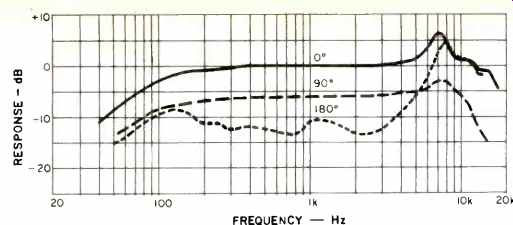
Fig. 4--Frequency response vs. angle, "M" response, plane wave.
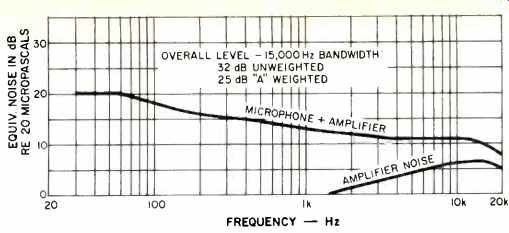
Fig. 5--One-third octave band noise spectrum with the Sony ECM-56F microphone.
Listening and Use Tests
The ECM-56F on "V" setting was talk-tested and compared to the BK-5B reference microphone on "VI" setting at six inches.
The ECM-56F sounded similar to the BK-5B except for a little less "prescence." This is the normal result of comparing a mike with ruler-flat response to the BK-5B. The high frequency peak in the Sony's frequency response was not evident.
A comparison test using recorded music and line acoustic guitar yielded results similar to speech. On some selections the ECM-56F sounded "cleaner" than the BK-5B, emphasizing some string overtones. The Sony sound was uniform for on- or off-axis sources out to 90°, whereas, the BK-5B sound varies drastically. For distant on-axis sources in our semi-reverberant studio, both mikes sounded similar at very high and very low frequencies. The Sony did pick up more ambient noise which in this case originated in the rear hemisphere.
We conclude, from both objective and subjective tests, that the Sony ECM-56F may be equal to more expensive air condensers but in a relatively limited range of environments.
It appears ideal for close miking of voice or instruments and, perhaps with the addition of a shockmount, is well suited to field recordings of rock, folk, or country music. It is well suited to close or distant miking in acoustically dead and quiet studios or auditoriums. Our tests showed that the ECM-56F is not particularly outstanding for reducing noise from the rear hemisphere, but we could not show that the non-uniform 180° response adds any coloration to on- or off-axis sources in a semi-reverberant room. Highly reverberant auditoriums are frequently noisy, and we would shy away from distant miking a live concert with ECM-56Fs in these rooms with an audience present.
The Sony has many fine acoustical, electrical, and mechanical features. The small size of the capsule, plus the technical articles, led us to expect uniform response and directivity to 15,000 Hz. Naturally, some design tradeoffs are to be expected to achieve all-around performance in a "non-system" condenser mike. Since it out-performed our $360.00 ribbon mike in at least one test, we must conclude that the Sony offers a high degree of performance at a moderate cost.
-Jon Sank
References
1) H. Kubota, "Back Electret, A Method to Improve Performance of Condenser Microphones of Electret Design." Paper given at AES Convention in Fall, 1976. AES Preprint 1157 (O-Z).
2) "The Compleat Microphone Evaluation . An Update," Audio, Sept., 1978, pp. 35-40.
(Source: Audio magazine, Jan. 1979)
Also see:
Sony Audio (microphones) (ad, May 1978)
Sony loudspeakers SSU-2000 (Dec. 1976)
SONY MDS-501 MINIDISC DECK (Nov. 1994)
= = = =